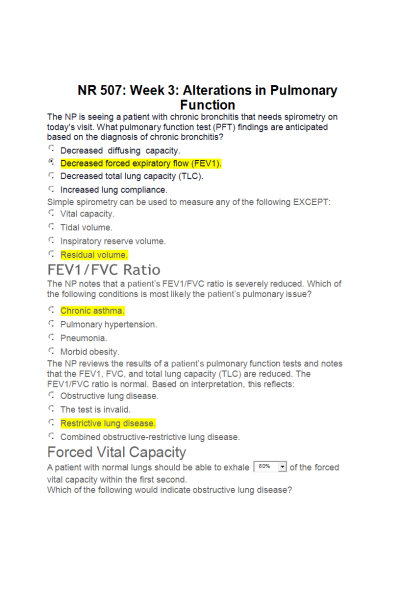NR 507 Week 3 Assignment; Alterations in Pulmonary Function
-
$39.00
| Institution | NR 507 Advanced Pathophysiology |
| Contributor | Laura Palmer |
- Question: The NP is seeing a patient with chronic bronchitis that needs spirometry on today's visit. What pulmonary function test (PFT) findings are anticipated based on the diagnosis of chronic bronchitis?
- Question: Simple spirometry can be used to measure any of the following EXCEPT:
FEV1/FVC Ratio
- Question: The NP notes that a patient’s FEV1/FVC ratio is severely reduced. Which of the following conditions is most likely the patient’s pulmonary issue?
- Question: The NP reviews the results of a patient’s pulmonary function tests and notes that the FEV1, FVC, and total lung capacity (TLC) are reduced. The FEV1/FVC ratio is normal. Based on interpretation, this reflects:
Forced Vital Capacity
- Question: A patient with normal lungs should be able to exhale of the forced vital capacity within the first second.
- Question: Which of the following would indicate obstructive lung disease?
FEV1/FVC Ratio
- Question: The NP notes that a patient’s FEV1/FVC ratio is normal. Which of the following conditions is most likely the patient’s pulmonary issue?
- Question: Chronic bronchitis will decrease which of the following parameters?
Simple Spirometry
- Question: Simple spirometry includes a measure of residual capacity.
Restrictive Lung Disease
- Question: Which of the following spirometry results indicate restrictive lung disease?
- Question: Which of the following is considered a late effect of emphysema?
Alpha-Antitrypsin 1 Deficiency
- Question: The effects of an Alpha-antitrypsin 1 deficiency is:
Chronic Bronchitis
- Question: A patient with chronic bronchitis is most likely to experience:
Chronic Bronchitis
- Question: The number one cause of chronic bronchitis is ______ .
Pulmonary Function Tests
- Question: Which of the following pulmonary function test results are expected in a patient with chronic bronchitis?
Signs and Symptoms
- Question: The signs and symptoms for chronic bronchitis and emphysema are compared in the table below. Can you identify which is which?
Lung Volume Measurement
- Question: A lung volume measurement that indicates air trapping in a COPD patient is:
X-Ray Findings
- Question: An expected chest x-ray finding for a patient with COPD is
Hyperresonance
- Question: Hyperresonance found on lung percussion with a patient with COPD is primarily due to ______
Cor Pulmonale
- Question: The NP is examining a patient with a longstanding history of chronic bronchitis. Cor pulmonale is expected in the patient that presents with:
Pneumonia Risk
- Question: A patient with chronic bronchitis is at risk for developing pneumonia due to:
Asthma
- Question: Asthma results in:
Gas Exchange
- Question: In normal gas exchange, which of the following is correct?
Asthma
- Question: Asthma is a chronic disease characterized by:
Extrinsic Asthma
- Question: Extrinsic asthma is _______ .
Intrinsic and Extrinsic Symptoms
- Question: Symptoms common to both intrinsic and extrinsic asthma include:
Asthma
- Question: Asthma is a chronic disease characterized by:
Extrinsic and Intrinsic Symptoms
- Question: Symptoms common to both intrinsic and extrinsic asthma include:
Extrinsic Asthma
- Question: Extrinsic asthma is:
Pulmonary Function Test
- Question: Which of the following pulmonary function test results are consistent with asthma?
Asthma
- Question: Asthma results in:
Interstitial Lung Disease
- Question: Choose the drugs that are commonly associated with development of a medication-induced interstitial lung disease (ILD):
Interstitial Lung Disease
- Question: Choose the types of interstitial lung diseases (ILD) that are commonly associated with smoking:
Interstitial Lung Disease
- Question: Interstitial lung disease (ILD) includes infectious and neoplastic lung diseases.
Subjective Findings
- Question: A subjective finding in interstitial lung disease is rhonchi in the upper posterior airways.
Interstitial Lung Disease
- Question: Interstitial lung disease refers to any disease affecting the pulmonary interstitium and typically excludes infectious and neoplastic diseases
Objective Findings
- Question: An objective finding in a patient with ILD include productive cough.
Diagnostic Tests
- Question: The four key diagnostic tests for interstitial lung disease are pulmonary function tests, high resolution CT scan, bronchoalveolar lavage and lung biopsy.
Common Symptoms
- Question: The symptoms that are common to all types of interstitial lung disease are shortness of breath and non-productive cough.
Interstitial Lung Diseases
- Question: Choose the interstitial lung diseases that are the most diagnosed:
Characteristic Findings
- Question: The characteristic finding of on a chest x-ray of an individual with ILD is a honey-comb pattern
| Instituition / Term | |
| Term | Year 2022 |
| Institution | NR 507 Advanced Pathophysiology |
| Contributor | Laura Palmer |





































